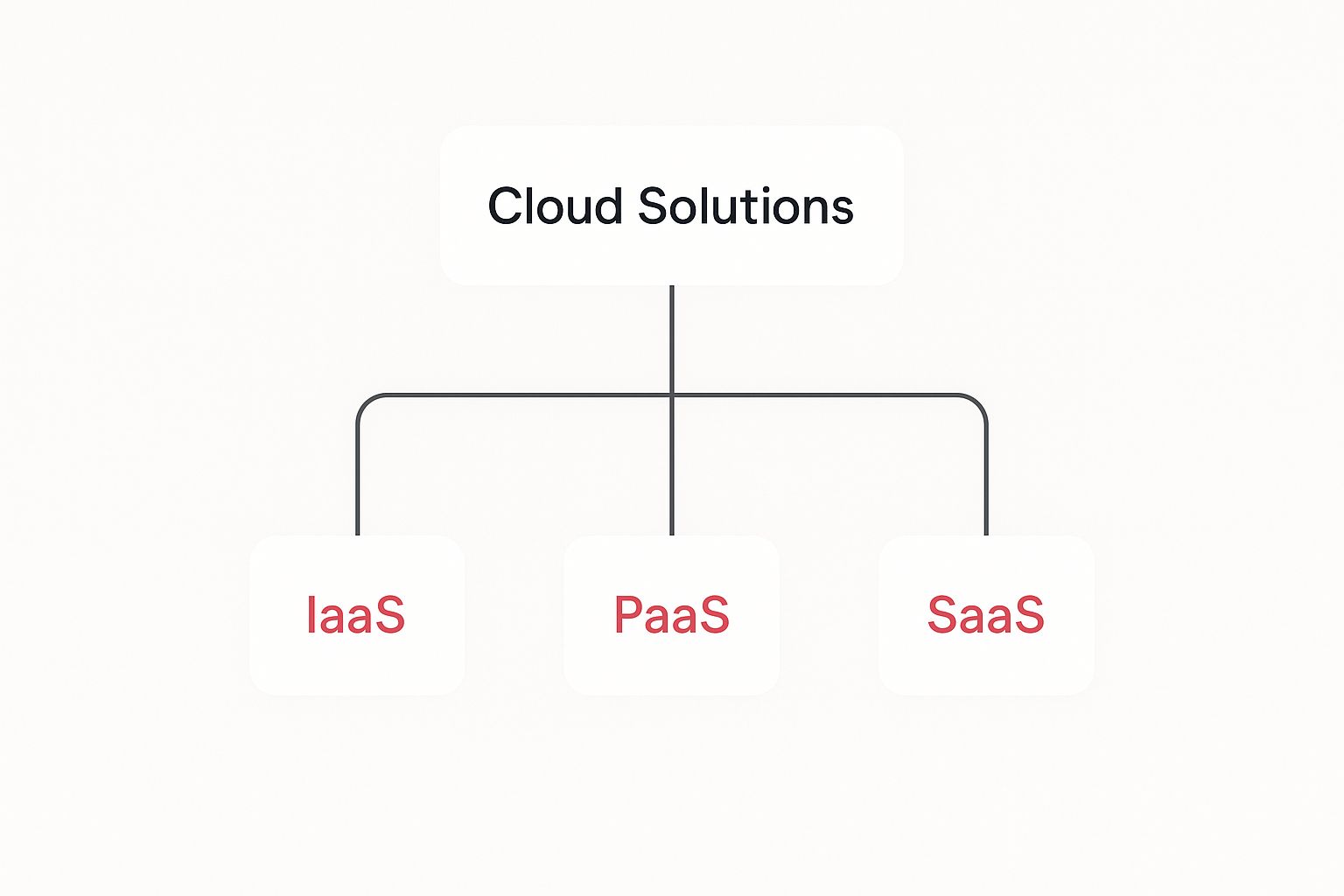Explore top cloud solutions for small businesses. Boost efficiency, security, and growth with our expert guide to the right cloud solutions for small businesses.

Cloud solutions offer small businesses a way to tap into top-tier technology, security, and scalability, all on a simple subscription basis. This completely removes the need for expensive, clunky hardware sitting in your office. For UK firms, this means operating more efficiently, slashing IT overheads, and being able to pivot quickly as the market changes. For a professional services firm, such as a solicitor's practice in Bournemouth, this translates to secure client file access from court, home, or the office, without the capital outlay on a physical server.

For many small and medium-sized enterprises (SMEs) across the UK, moving to the cloud is no longer just a technical upgrade—it's a core business strategy. It's about shifting focus from managing complicated IT in-house to concentrating on what actually grows your business and makes you profitable.
Let's put it another way. Sticking with an old-school server in your office is a bit like running your own private power generator. It's expensive to set up, needs an expert to keep it running, and if it breaks down, your entire operation grinds to a halt.
Now, contrast that with adopting cloud solutions for small businesses. That's like plugging into the national grid. You get a steady, reliable supply managed by specialists, and you only pay for what you actually use. It’s not just about convenience; it’s about building real resilience into your business.
If you run a professional services firm, like a law practice or an accountancy firm, the advantages are incredibly clear. You're handling sensitive client data and relying on smooth collaboration to hit deadlines. An on-premise system is riddled with risks, from hardware failure and data loss to glaring cybersecurity holes.
The cloud tackles these problems head-on. It gives you:
Adopting the cloud is really about future-proofing your business. It gives you the foundation you need to compete, serve your clients better, and let your team work securely from anywhere.
This guide will walk you through the entire process, specifically for UK business owners. We'll give you practical, no-nonsense advice to help you figure out your options and plan a smooth transition, so you can make the most of cloud technology with complete confidence.
Choosing the right cloud solutions for your small business means getting to grips with what’s actually on offer. It's less like buying a single product and more like picking from a menu of services, each designed to solve different problems. These services fall into three main models, and the key difference between them is how much control and management you have versus what the provider handles for you.
This diagram helps to visualise how these three core models fit together.

As you can see, almost every cloud service you encounter will be a version of IaaS, PaaS, or SaaS. Understanding what they mean for your business is the first step to making a smart decision.
First up is Infrastructure as a Service (IaaS). This is the most hands-on, foundational cloud model. The best way to think of it is like leasing a fully serviced plot of land. The provider gives you the core components—the raw server power, storage space, and networking—but you're responsible for building everything else on top. That includes the operating system, the security, and all your applications.
This approach gives you the ultimate level of control and flexibility. For example, a small financial modelling firm in Manchester might use IaaS to build and test a highly specialised analytics application. They can pick the exact operating system and development tools they need without being boxed into a pre-set environment.
IaaS is for you if: You have the in-house technical know-how and need complete control over your digital infrastructure. It’s about getting the raw materials to build precisely what you need, from the ground up.
Moving up a level, we get to Platform as a Service (PaaS). If IaaS is an empty plot of land, PaaS is like renting a fully equipped workshop. The provider manages all the underlying infrastructure for you—the servers, the operating system, the security patching. They hand you a ready-made environment with all the tools you need to build, test, and run your own software.
Imagine a small business consultancy in Hampshire wanting to develop a unique client portal. With PaaS, they could focus all their energy on creating an amazing customer experience, using the platform's tools to build their site. They wouldn't have to waste time worrying about server updates or network configuration. It's a fantastic way to speed up development.
Finally, we have Software as a Service (SaaS), which is by far the most common and user-friendly model. Think of this as simply subscribing to a finished service. You don't manage the infrastructure or the platform; you just log in through your web browser and start using the application.
It's no surprise that SaaS has become so popular. In the UK, a staggering 72% of businesses with fewer than 50 employees use SaaS platforms as their primary software source. The drivers are clear: flexibility, predictable costs, and scalability. This trend is even more pronounced among the smallest companies, with 42% of microbusinesses increasing their cloud adoption recently.
You're likely already using SaaS every day. For professional service firms, common examples include:
SaaS is for you if: You want immediate access to powerful, ready-to-use software on a simple subscription. It completely removes the headache of installation, updates, and maintenance.
To make the differences even clearer, this table breaks down who manages what and which model is best for certain scenarios.
Ultimately, many businesses create a hybrid environment, mixing and matching these services to get the job done. For instance, a firm might run its entire day-to-day operations on SaaS tools. For key communication upgrades, looking into virtual phone systems for small businesses is a perfect example of a popular SaaS solution. This blended approach lets a company take advantage of ready-made software for most tasks while keeping direct control over more specialised systems where it really counts.

Knowing the different types of cloud services is one thing, but the question every business owner really asks is: what’s in it for me? For small businesses, adopting cloud solutions isn't about chasing the latest tech trend. It's about getting real, measurable advantages that directly strengthen your finances and your ability to bounce back from disruption.
The benefits hit right at the core challenges that small and medium-sized businesses grapple with every day, from keeping a tight rein on budgets to protecting sensitive client data.
Moving to the cloud fundamentally changes how you approach IT spending, your team's productivity, and your company's agility. It’s about turning technical features into genuine business value and finding a smarter way to operate.
One of the first and most compelling benefits is the complete shift in how you pay for technology. The old way involved huge upfront investments in servers, software licences, and the people needed to maintain it all. This is known as Capital Expenditure (CapEx), and it can be a massive drain on a small business's cash flow.
Cloud solutions flip this model on its head. You move to a subscription-based system, or Operational Expenditure (OpEx). You pay a predictable monthly or yearly fee, which makes budgeting far easier and removes the risk of a sudden, hefty bill for a hardware upgrade. This frees up cash that can be put straight back into growing the business—whether that's through marketing, hiring new talent, or product development.
The subscription model isn't just about predictable costs; it's about getting your hands on enterprise-grade technology that would otherwise be completely out of reach. You can use the same powerful tools as your biggest competitors without the eye-watering initial price tag.
This move from CapEx to OpEx is a major reason so many businesses are making the switch. Beyond the cost savings, other drivers include greater flexibility, scalability, and the need to support remote work. In fact, the rise of remote working was cited by 29% of organisations as a key factor, making seamless cloud collaboration tools essential.
Business demands are rarely predictable. You might hit a seasonal peak, land a massive project, or need to support a last-minute marketing campaign. With traditional on-site hardware, scaling up to meet these demands is a slow and expensive process that often involves buying new physical kit.
Cloud services, on the other hand, are elastic. You can ramp your resources up or down almost instantly, and you only ever pay for what you actually use.
This pay-as-you-go flexibility means you're never overpaying for idle capacity or getting caught short when opportunity knocks. It allows your business to be nimble and responsive, unburdened by rigid IT infrastructure.
With hybrid and remote work now the norm, effective collaboration is more important than ever. Cloud-based tools are the engine that drives this modern way of working, keeping teams connected and productive no matter where they are.
Platforms like Microsoft 365 or Google Workspace let employees edit documents together in real-time, share files securely, and communicate without a hitch. For a team of surveyors, this means updating a report from a site on a tablet, knowing the project manager back in the office sees the changes instantly. All the data is stored in one central place, accessible from any device with an internet connection. This ensures everyone is working from the latest version, putting an end to the chaos of managing multiple file versions and streamlining workflows for better team efficiency. As many have discovered, these cloud computing benefits for businesses go far beyond simple file sharing.
For many small business owners, the thought of storing sensitive data off-site can feel a bit unnerving. In reality, though, the major cloud providers offer a level of security that is far beyond what most small businesses could ever hope to achieve on their own.
These companies invest billions in securing their data centres. They employ armies of cybersecurity experts and use sophisticated, round-the-clock threat detection systems.
What's more, cloud solutions make critical security practices much simpler. Automated backups, for instance, mean your data is regularly copied and stored safely in multiple locations. This provides rock-solid disaster recovery. If your office were ever affected by a fire, flood, or theft, your essential business data would remain safe and could be restored quickly, keeping downtime and disruption to an absolute minimum.
For many small business owners, the thought of moving sensitive client data onto someone else’s servers is a major sticking point. It’s a completely understandable concern, but it often stems from a misunderstanding that security becomes the provider's problem alone. The reality is more of a partnership, which the industry calls the Shared Responsibility Model.
Let's use an analogy. Imagine you're renting a space in a high-security storage facility. The company running the facility is responsible for the building's physical integrity—the thick concrete walls, the steel doors, the alarms, and the security guards. They provide a level of security you could never hope to build yourself.
But you are still responsible for what you put inside your unit, who you give a key to, and making sure that key isn't left on your desk. The cloud provider builds and maintains the fortress; you control the keys to your own little corner of it.
This shared approach means your provider is responsible for the security of the cloud (the physical hardware, the network infrastructure). Meanwhile, you are responsible for security in the cloud. This covers your data, your applications, and, crucially, who can get to them. Taking this on board isn't just good practice; it's fundamental to protecting your business and your clients.
Effective security isn't about becoming a tech wizard overnight. It’s about consistently applying a few high-impact, common-sense practices.
These measures are the foundation of a solid security setup:
By focusing on these three areas, a small business can massively reduce its exposure to the most common cyber threats. It’s about being proactive with who can access what, rather than just reacting after a breach.
For any UK business handling client information, data security is inseparable from legal compliance. The main piece of legislation here is the General Data Protection Regulation (GDPR), which dictates how you must collect, process, and store personal data.
A key part of GDPR is data sovereignty—the principle that data is subject to the laws of the country where it is physically stored. This is precisely why the location of your cloud provider's data centres is so critical.
If your firm—say, an accountancy practice in Dorset or a legal practice in Hampshire—stores client data on servers outside the UK, you could be accidentally breaking data protection laws. The consequences can be severe, from huge fines to lasting reputational damage. To stay compliant and give your clients peace of mind, you must choose a provider that hosts your data in UK-based data centres. This ensures your information falls squarely under UK law.
Storing data locally also tends to improve performance and reduce lag, which helps create a more reliable system. If you're interested in building resilient systems, you can learn more by reading our article explaining what network redundancy is.

Choosing a cloud provider is one of the most critical decisions you'll make for your small business. This isn't just about comparing prices; it’s about finding a true partner whose technology, support, and reliability are a perfect match for how you work and where you want to go. A deliberate, step-by-step approach is the best way to find a service that solves today's problems and grows with you tomorrow.
The whole process can be broken down into three logical phases: auditing your specific needs, evaluating potential partners, and then carefully planning the move. By tackling each step in order, you can sidestep common mistakes and build a successful, long-term relationship.
Before you even start looking at providers, you need to look inward. A thorough audit of your current operations and technical requirements is the foundation for making the right choice. If you don't have a crystal-clear picture of what you need, you'll never know if a provider is a good fit.
Start by mapping out your key business processes. How do you handle client information? Where are your critical files stored and shared? What software do you rely on every day for accounting, project management, or communicating with customers? Answering these questions gives you a detailed blueprint of what you actually need a cloud solution to do.
For example, a small accountancy firm in Hampshire might find their biggest headache is the cumbersome, manual process of sharing large financial reports with clients via insecure email attachments. Their top priority would be a solution with a secure, user-friendly client portal and solid access controls. This simple insight immediately helps them narrow the field.
Once you have that blueprint of your needs, you can start sizing up potential providers. This is where you shift from an internal review to an external evaluation, comparing what different services offer against your specific checklist.
It’s vital to look past the marketing slogans and dig into the details that will impact your daily work. The right provider will offer concrete guarantees and features that line up perfectly with what you’ve identified as essential.
Key things to compare include:
This focused evaluation helps you create a shortlist of providers who aren't just selling a generic service, but offering a genuine solution to your unique business challenges.
After you've picked your provider, the final step is planning the move itself. A classic mistake is to try a "big bang" switch, moving everything at once. This is a high-risk strategy that can lead to major disruption if anything goes wrong.
A much safer and smarter approach is a phased migration. This involves moving your systems to the cloud in manageable stages. It gives you the chance to test, troubleshoot, and ensure everything is stable at each step, which minimises risk and helps your team build confidence with the new setup.
A phased migration allows your business to adapt gradually, ensuring each component is working perfectly before the next is introduced. This methodical approach is the hallmark of a well-executed cloud transition.
For example, a small legal practice might decide to move its email and calendars to the cloud first. Once that's running smoothly and the team is comfortable, they can move on to their document management system, followed finally by their more complex case management software. This step-by-step process guarantees a smooth transition with minimal interruption to client service.
This kind of strategic investment reflects what's happening in the wider market. Globally, spending on public cloud services is projected to hit $723.4 billion in 2025, a massive leap from $595.7 billion in 2024. Closer to home, 54% of UK SMBs are expected to spend over $1.2 million annually on cloud services by 2025, showing a clear commitment to gaining scale and a competitive edge. You can find more insights on this growing investment at CloudZero.
Thinking about moving to the cloud can feel like a massive technical project, but it doesn't have to be. For a small business, it’s really about making a smart decision to build a more resilient and efficient company, giving you a real edge over the competition. It’s a chance to swap out clunky old systems for tools that are genuinely more powerful and flexible.
The trick is to stop seeing the cloud as some daunting, far-off goal. Instead, think of it as a tool you can use right now to help your business grow. And you can start today with a few simple, practical actions.
Don't fall into the trap of trying to move everything at once. That's a recipe for headaches. A much better approach is to focus on making one meaningful change at a time. This way, you minimise risk and get to see the benefits almost immediately.
Here’s a clear, manageable checklist to get you started:
This simple three-step process demystifies the entire transition. It turns a big decision into a small, low-risk experiment focused on solving a real-world problem.
When you're ready to start moving your data, having a solid plan is non-negotiable. For a detailed guide on this crucial stage, this excellent data migration strategy playbook offers some brilliant advice. Taking these first small steps puts you firmly on the path to a more agile and secure future.
Moving your business to the cloud is a big step, and it's natural to have questions. We've gathered the most common queries we hear from UK small business owners to give you the clear, straightforward answers you need to move forward with confidence.
There’s no single price tag for the cloud; it’s more like a menu where you only pay for what you actually use. For a small professional services firm, you might be looking at £10-£50 per user, per month for essential tools like Microsoft 365 or a good quality VoIP phone system.
Of course, costs go up as your needs become more complex. If you need a virtual server to run your own custom software, the monthly spend will be higher. The real win here is swapping a massive upfront cost for servers and hardware for a predictable, manageable operating expense.
This is probably the most important question, and for good reason. The top cloud providers spend billions on security—far more than any small business could ever afford. They have teams of cybersecurity experts, advanced threat detection systems, and incredibly secure data centres.
But it's a partnership. Think of the provider as securing the fortress, while you're in charge of the keys. Your responsibility is to manage who has access. By using strong passwords, multi-factor authentication, and smart user permissions, you can build a security setup that’s often much stronger than what you'd have in your own office.
It's also vital to choose a provider that keeps your data in UK-based data centres. This ensures your information is protected by UK law and stays fully compliant with GDPR.
Getting your head around these models is key to finding the right fit for your business, balancing control with cost.
For the vast majority of small businesses, the public cloud hits that sweet spot of security, flexibility, and affordability.
For many small businesses, the answer is no. If you’re mainly using applications like Xero or Microsoft 365, they're designed to be simple to use. The provider handles all the tricky stuff—updates, security, and maintenance—which is a massive weight off your shoulders.
If you start using more advanced services or a hybrid setup, then it's a good idea to work with a managed service provider (MSP). They act as your expert IT team, managing the technical side of things without the expense of hiring someone full-time.
At SES Computers, we specialise in providing dependable, UK-hosted cloud services and managed IT support designed for small and medium-sized businesses across Dorset, Hampshire and beyond. We can help you find your way through the options and build a secure, scalable solution that helps your business grow. Learn more about our approach at https://www.sescomputers.com.